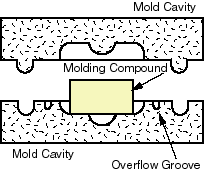Compression molding is one of the original processing methods for manufacturing plastic parts developed at the very beginning of the plastics industry. In fact, it was widely used in the bakery industry for cookie or cake molding before plastic materials existed.
Aalthough it is also applicable to thermoplastics, compression molding is commonly used in manufacturing thermoset plastic parts. The raw materials for compression molding are usually in the form of granules, putty-like masses, or preforms. They are first placed in an open, heated mold cavity. The mold is then closed and pressure is applied to force the material to fill up the cavity. A hydraulic ram is often utilized to produce sufficient force during the molding process. The heat and pressure are maintained until the plastic material is cured.
 |
1.Molding compound is placed in an open, heated mold cavity. |
 |
2.The mold is closed and pressure is then applied to force the material to fill up the entire mold cavity. Excess material is channelled away by the overflow grooves. The heat and pressure are maintained until the plastic material is cured. |
 |
3.The final part after the mold is removed. |
There are two different types of compounds most frequently used in compression molding: Bulk Molding Compound (BMC) and Sheet Molding Compound (SMC). SMC costs higher but can be pre-cut to conform to the surface area of the mold. The more evenly distributed material over the mold surface usually results in less flow orientation during the compression stage and, therefore, higher product consistency.
Compression molding is commonly used for manufacturing electrical parts, flatware, gears, buttons, buckles, knobs, handles, electronic device cases, appliance housing, and large container.
Common plastics used in compression molding processes include
Polyester
Polyimide (PI)
Polyamide-imide (PAI)
Polyphenylene Sulfide (PPS)
Polyetheretherketone (PEEK)
Fiber reinforced plastics
There are four primary factors in a successful compression molding process:
Amount of material
Heating time and technique
Force applied to the mold
Cooling time and technique
Pros and Cons of Compression Molding
Pros
Low initial setup costs
Fast setup time
Capable of large size parts beyond the capacity of extrusion techniques
Allows intricate parts
Good surface finish (in general)
Wastes relatively little material
Can apply to composite thermoplastics with unidirectional tapes, woven fabrics, randomly orientated fiber mat or chopped strand
Compression molding produces fewer knit lines and less fiber-length degradation than injection molding.
Cons
Production speed is not up to injection molding standards
Limited largely to flat or moderately curved parts with no undercuts
Less-than-ideal product consistency

